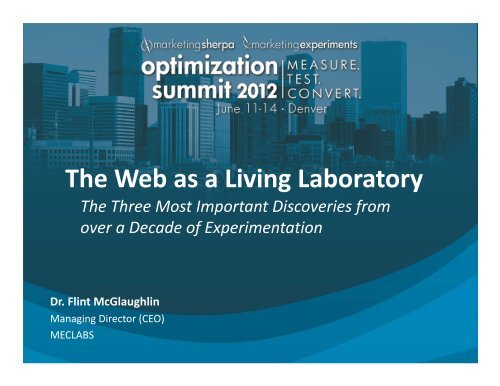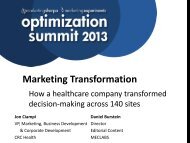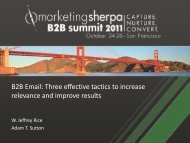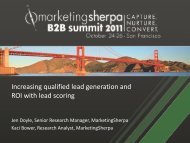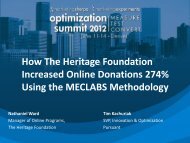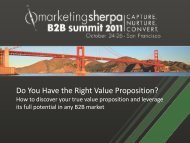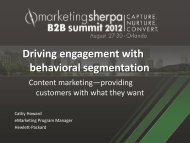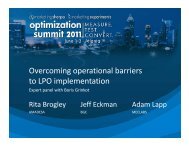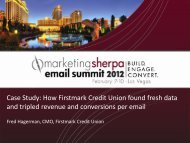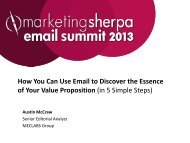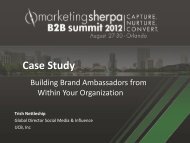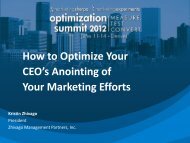The Web as a Living Laboratory: How MECLABS uses Internet ...
The Web as a Living Laboratory: How MECLABS uses Internet ...
The Web as a Living Laboratory: How MECLABS uses Internet ...
You also want an ePaper? Increase the reach of your titles
YUMPU automatically turns print PDFs into web optimized ePapers that Google loves.
<strong>The</strong> <strong>Web</strong> <strong>as</strong> a <strong>Living</strong> <strong>Laboratory</strong><br />
<strong>The</strong> Three Most Important Discoveries from<br />
over a Decade of Experimentation<br />
Dr. Flint McGlaughlin<br />
Managing Director (CEO)<br />
<strong>MECLABS</strong>
Experiment #1: Background<br />
Experiment ID: REGOnline Homepage Test<br />
Location: MarketingExperiments Research Library<br />
Test Protocol Number: TP1427<br />
Research Notes:<br />
Background: REGOnline is event management software that lets users create<br />
online registration forms and event websites to manage their events.<br />
Goal: To incre<strong>as</strong>e number of completed leads on home page.<br />
Primary research question: Which page will achieve the greatest addressable<br />
lead rate?<br />
Approach: A/B multifactor split test<br />
2
Experiment #1: Control<br />
Control ‐ Homepage<br />
• Our researchers<br />
hypothesized that we could<br />
incre<strong>as</strong>e the appeal<br />
<strong>as</strong>sociated with the value<br />
proposition of this offer by<br />
focusing more on the<br />
product and its specific<br />
features and benefits.<br />
3
Experiment #1: Treatment<br />
Treatment ‐ Homepage<br />
• Headline w<strong>as</strong> written to focus<br />
more on the product.<br />
• Specific features and benefits<br />
are utilized to express the<br />
value.<br />
• <strong>The</strong> page emph<strong>as</strong>izes “Free<br />
Access.”<br />
• Also, ensured that this value<br />
w<strong>as</strong> being communicated in<br />
subsequent steps.<br />
4
Experiment #1: Side‐by‐side<br />
Control<br />
Treatment<br />
5
Experiment #1: Results<br />
24.5% Decre<strong>as</strong>e in Conversion<br />
<strong>The</strong> Treatment generated 24.5% less completed leads<br />
Versions<br />
Conversion<br />
Rate<br />
Rel. diff<br />
Control –Two‐step homepage 2.3% ‐<br />
Treatment –Three‐step homepage 1.7% ‐24.5%<br />
<br />
What you need to understand: In spite of having clearer value and reducing<br />
the amount of form fields in the first step, the control still outperformed<br />
the treatment.<br />
6
HOW can we improve this page?<br />
Control ‐ Homepage<br />
7
What you need to understand<br />
Key Principles<br />
1. Asking “how” leads to information; <strong>as</strong>king “why” leads to wisdom.<br />
Yet marketers are all too busy <strong>as</strong>king how.<br />
8
Key “Why” Questions<br />
WHY did the treatment<br />
decre<strong>as</strong>e conversion by 25%?<br />
WHY did the more people say<br />
“yes” to the control<br />
9
<strong>The</strong> Problem: Few View the <strong>Internet</strong> <strong>as</strong> a Lab<br />
Which of the following ways does your organization use the <strong>Internet</strong>?<br />
Marketing Channel<br />
64%<br />
Informational Resource<br />
37%<br />
Marketing Hub<br />
30%<br />
Customer Research Lab<br />
10%<br />
Brand Research Lab<br />
6%<br />
Source: ©2012 MarketingSherpa <strong>Web</strong>site Optimization Benchmark Survey<br />
Methodology: Fielded April 2012, N=2,677<br />
10
Experiment #2: Background and Test Design<br />
Experiment ID: REGonline SEO landing page test<br />
Location: MarketingExperiments Research Library<br />
Test Protocol Number: TP3055<br />
Research Notes:<br />
Background: A technology and media company specializing in online registration and<br />
event management software.<br />
Goal: To incre<strong>as</strong>e the amount of leads generated online.<br />
Primary research question: Which online capture process will generate the highest<br />
addressable lead rate?<br />
Approach: A/B multifactor split test<br />
11
Experiment #2: Background<br />
Homepage from<br />
Previous Test<br />
• Before we could get a lift, we<br />
needed to learn more about<br />
the prospects coming to this<br />
site.<br />
24.5%<br />
Decre<strong>as</strong>e in Conversion<br />
• We decided to use one of<br />
their SEO pages <strong>as</strong> a research<br />
window into the cognitive<br />
psychology of the customer’s<br />
motivation.<br />
u = 2q + t + m + 2v + i ©<br />
12
Experiment #2: Control<br />
SEO Landing Page<br />
• This landing page w<strong>as</strong><br />
offering the same<br />
product <strong>as</strong> the home<br />
page but dealt with a<br />
smaller subset of<br />
visitors that matched<br />
the profile of those<br />
coming to the<br />
homepage.<br />
• Our researchers could<br />
test here without the<br />
negative consequences<br />
of hurting conversion<br />
on the homepage.<br />
13
Experiment #2: Treatment<br />
Treatment SEO Landing Page<br />
• For our first test on this<br />
page, we tested<br />
focusing on how this<br />
product enabled<br />
creating registration<br />
forms e<strong>as</strong>ier and could<br />
cut their time in half…<br />
• …and yet it still had a<br />
robust functionality.<br />
14
Experiment #2: Side‐by‐side<br />
Control<br />
Treatment<br />
Do you think the new emph<strong>as</strong>is will out perform the control?<br />
If so, by how much?<br />
15
Experiment #2: Results<br />
548% Incre<strong>as</strong>e in Complete Leads<br />
<strong>The</strong> new page’s conversion rate incre<strong>as</strong>ed by 548.46%<br />
Design<br />
Conversion Rate<br />
(%)<br />
Relative<br />
Difference<br />
Statistical Level<br />
of Confidence<br />
Original Page 0.7% ‐ ‐<br />
Treatment 4.8% 548%<br />
99%<br />
What you need to understand: By applying key optimization<br />
methodologies to the lead capture process, the treatment w<strong>as</strong> able to<br />
improve step‐level clickthrough rates by 1,312%, and completed leads<br />
captured by 548%.<br />
16
Experiment #2: Learning Applied<br />
SEO Page Test<br />
Original Homepage<br />
New Home Page Test<br />
548% Learning Learning<br />
90%<br />
• We were able to take what we learned about the motivations of their<br />
customers from testing on the SEO landing page and apply it to the<br />
homepage, which generated a 90% incre<strong>as</strong>e in leads captured.<br />
17
What you need to understand<br />
Key Principles<br />
1. Asking “how” leads to information; <strong>as</strong>king “why” leads to wisdom. Yet<br />
marketers are all too busy <strong>as</strong>king how.<br />
2. Sometimes we need to slow down in order to go f<strong>as</strong>t. Action is<br />
overrated; action should be grounded in contemplation. Admittedly,<br />
contemplation without action is anemic, but then action without<br />
contemplation is dangerous.<br />
18
What you need to understand<br />
Key Principles<br />
1. Asking “how” leads to information; <strong>as</strong>king “why” leads to wisdom. Yet<br />
marketers are all too busy <strong>as</strong>king how.<br />
2. Sometimes we need to slow down in order to go f<strong>as</strong>t. Action is<br />
overrated; action should be grounded in contemplation. Admittedly,<br />
contemplation without action is anemic, but then action without<br />
contemplation is dangerous.<br />
3. Indeed, the marketer should be the philosopher of the organization ‐‐<br />
for the vigorous action of sales needs to be grounded in the rigorous<br />
contemplation of marketing.<br />
19
<strong>The</strong> Marketer <strong>as</strong> Philosopher<br />
Three Critical Observations
Receive Advance Notice of Dr. McGlaughlin's New Book<br />
<strong>The</strong> Marketer<br />
<strong>as</strong> Philosopher<br />
By Dr. Flint McGlaughlin’s<br />
• To receive advance notice of<br />
the publication of Dr.<br />
McGlaughlin’s upcoming book,<br />
<strong>The</strong> Marketer <strong>as</strong> Philosopher.<br />
…and…<br />
• To get a key excerpt that<br />
explains the Inversion of the<br />
Funnel with the Micro‐Yes Map.<br />
Visit the following webpage:<br />
www.meclabs.com/philosophy
OBSERVATION #1:<br />
All Marketing is Comprised of 4 Elements<br />
22
OBSERVATION #1:<br />
<strong>The</strong> Four Elements of Marketing<br />
<strong>The</strong> Message<br />
<strong>The</strong> Marketer<br />
<strong>The</strong> Market<br />
<strong>The</strong> Means<br />
23
OBSERVATION #1:<br />
Marketing Dangers<br />
THE DANGER OF COMPANY LOGIC<br />
24
OBSERVATION #1:<br />
Experiment: Background<br />
Experiment ID: (Protected)<br />
Location: MarketingExperiments Research Library<br />
Test Protocol Number: TP1341<br />
Research Notes:<br />
Background: A company offering dedicated business hosting services<br />
Goal: To incre<strong>as</strong>e the amount of leads<br />
Primary research question: Which page design will generate the greatest<br />
amount of leads?<br />
Approach: A/B multi‐factor split test (radical redesign)<br />
25
OBSERVATION #1:<br />
Experiment: Original<br />
26
OBSERVATION #1:<br />
Experiment: Original<br />
• <strong>The</strong> banner is the first thing that people see when arriving at this page, but what does it<br />
mean? It might mean something to the company, but it conveys little value to the<br />
prospect.<br />
27
OBSERVATION #1:<br />
Experiment: Original<br />
• This company only truly needs 4 fields in order to obtain a qualified lead, and yet 20<br />
different fields must be completed on this page.<br />
• Call to action “Request a Quote” is impersonal and implies commitment and cost.<br />
28
OBSERVATION #1:<br />
Experiment: Original vs. Treatment<br />
29
OBSERVATION #1:<br />
Experiment: Treatment<br />
• Immediately lets the visitor know where<br />
the are and what they can do on this<br />
page.<br />
• Provides organized content that the<br />
prospect could navigate through b<strong>as</strong>ed<br />
on their own needs<br />
• Uses images with e<strong>as</strong>ily understandable<br />
meaning<br />
• Uses the more personal/ lower<br />
commitment call‐to‐action language of<br />
“Call to Discussing Your Needs”<br />
• Moves all unnecessary forms fields to a<br />
secondary step.<br />
30
OBSERVATION #1:<br />
Experiment: Original vs. Treatment<br />
31
OBSERVATION #1:<br />
Experiment: Result<br />
189% Incre<strong>as</strong>e in Overall Conversion<br />
<strong>The</strong> new page’s conversion rate incre<strong>as</strong>ed by 188.46%<br />
Design Conversion Rate (%)<br />
Relative<br />
Difference<br />
Statistical Level<br />
of Confidence<br />
Original Page 2.00% ‐ ‐<br />
Treatment 5.77% 188.46%<br />
95%<br />
32
OBSERVATION #2:<br />
<strong>The</strong> Goal of the Marketer is to Move the Prospect<br />
Up, Not Down, the Funnel<br />
33
OBSERVATION #2:<br />
<strong>The</strong> Inverted Funnel<br />
1. <strong>The</strong> funnel is often presented <strong>as</strong><br />
one potentially useful analogy for<br />
marketing. It is in fact, the<br />
primary analogy. All marketing<br />
should influence a decision.<br />
2. <strong>The</strong> funnel analogy distorts<br />
reality. People are not falling into<br />
your funnel, they are falling out.<br />
<strong>The</strong> funnel must be inverted.<br />
g= 9.81 m/s 2<br />
3. People don’t travel down the<br />
center of the funnel. People are<br />
climbing up the sides.<br />
34
OBSERVATION #2:<br />
<strong>The</strong> Inverted Funnel<br />
(Ma)YES<br />
Y<br />
Sales Call<br />
(Mi)YES<br />
(Mi)YES<br />
Landing Page<br />
Business Software Suite<br />
#1 On‐Demand. 6459+ World Clients<br />
Award‐Winning Solution. Free Trial<br />
www.XXXXXXXXXX.com/Business<br />
PPC Ad<br />
(Mi)YES<br />
(Mi)YES<br />
(Mi)YES<br />
(Mi)YES<br />
<strong>The</strong> Message<br />
35
OBSERVATION #2:<br />
Marketing Dangers<br />
THE DANGER OF CONFLATED OBJECTIVES<br />
36
OBSERVATION #2:<br />
Experiment: Background<br />
Experiment ID: Email Messaging Test<br />
Location: MarketingExperiments Research Library<br />
Research Notes:<br />
Background: Largest physician‐only social network which offers its knowledge<br />
b<strong>as</strong>e to pharmaceutical companies.<br />
Goal: To incre<strong>as</strong>e email clickthrough from rented list to landing page.<br />
Primary research question: Which email will generate the highest<br />
clickthrough rate?<br />
Approach: Multifactor sequential (year‐to‐year) test.<br />
37
OBSERVATION #2:<br />
Experiment: Email control<br />
Company<br />
• This page, though above<br />
average in many<br />
respects, still h<strong>as</strong><br />
conflated the objective<br />
of the email with the<br />
objective of the landing<br />
page.<br />
• This email is selling and<br />
<strong>as</strong>king for too much at<br />
this stage in the<br />
conversion process.<br />
38
OBSERVATION #2:<br />
Experiment: Email control<br />
Email<br />
Subject Line<br />
Landing Page<br />
Headline<br />
Company<br />
Headline<br />
First Two<br />
Inches<br />
First Two<br />
Inches<br />
Body<br />
Body<br />
CTA<br />
CTA<br />
39
OBSERVATION #2:<br />
Experiment: Email treatment<br />
• Each section of the<br />
page guides the reader<br />
through a logical series<br />
of micro‐conversions.<br />
Company Name<br />
Optimized Email<br />
Name<br />
Number<br />
• Call to action <strong>as</strong>ks for<br />
just the right amount<br />
of commitment at<br />
this stage of the<br />
conversion process.<br />
Name<br />
Name<br />
Name<br />
Name<br />
40
OBSERVATION #2:<br />
Experiment: Side‐by‐side<br />
Original<br />
Optimized<br />
Company<br />
Company Name<br />
Number<br />
Nam<br />
e<br />
Name<br />
Name<br />
41
OBSERVATION #2:<br />
Experiment: Results<br />
104% incre<strong>as</strong>e in conversion<br />
<strong>The</strong> treatment generated a 104% higher clickthrough rate.<br />
Versions Clickthrough Rate Relative difference<br />
Control 1.55% ‐<br />
Treatment 3.16% 104%<br />
<br />
What you need to understand: By changing the messaging of the email to<br />
reflect the company’s value proposition, we were able to generate a 104%<br />
lift in clickthrough rate.<br />
42
OBSERVATION #3:<br />
<strong>The</strong> Value Proposition is the Force Which Compels<br />
the Prospect Up the Funnel<br />
43
OBSERVATION #3:<br />
<strong>The</strong> Force of the Value Proposition<br />
(Mi)YES<br />
(Mi)YES<br />
(Mi)YES<br />
(Mi)YES<br />
(Mi)YES<br />
(Ma)YES<br />
Value Proposition<br />
<strong>The</strong> Message<br />
Value Proposition<br />
Y<br />
1. <strong>The</strong> answer to the question,<br />
“What is your value proposition?”<br />
can only be discovered by<br />
answering yet another question: If<br />
I am your ideal prospect, why<br />
should I buy from you rather than<br />
any of your competitors?<br />
44
OBSERVATION #3:<br />
<strong>The</strong> Force of the Value Proposition<br />
Value Proposition Question: If I am your ideal prospect, why should I<br />
buy from you rather than your competitors?<br />
1. You are fundamentally answering a first‐person question posed in the mind of your<br />
customers.<br />
2. A value proposition foc<strong>uses</strong> on a specific customer segment. This requires you to<br />
consider who you are not going to serve and the <strong>as</strong>sociated tradeoffs.<br />
3. A value proposition h<strong>as</strong> a specific action in mind. It is seeking to answer “why” for a<br />
specific “what.”<br />
4. A value proposition must differentiate you from your competitors. In at le<strong>as</strong>t one<br />
way, you must have an “only” factor.<br />
45
OBSERVATION #3:<br />
<strong>The</strong> Force of the Value Proposition<br />
Perceived<br />
Cost<br />
Perceived<br />
Value<br />
46
OBSERVATION #3:<br />
<strong>The</strong> Force of the Value Proposition<br />
(Ma)YES<br />
Y<br />
(Mi)YES<br />
For the Primary, Product, Prospect, and Process‐<br />
Level Value Propositions, the objective is to tip<br />
the perceived value (Pv) to be greater than the<br />
perceived cost (Pc).<br />
(Mi)YES<br />
(Mi)YES<br />
(Mi)YES<br />
(Mi)YES<br />
Value Proposition<br />
<strong>The</strong> Message<br />
Value Proposition<br />
47
OBSERVATION #3:<br />
<strong>The</strong> Force of the Value Proposition<br />
(Ma)YES<br />
Y<br />
(Mi)YES<br />
For the Primary, Product, Prospect, and Process‐<br />
Level Value Propositions, the objective is to tip<br />
the perceived value (Pv) to be greater than the<br />
perceived cost (Pc).<br />
(Mi)YES<br />
(Mi)YES<br />
(Mi)YES<br />
(Mi)YES<br />
Value Proposition<br />
<strong>The</strong> Message<br />
Value Proposition<br />
48
OBSERVATION #3:<br />
<strong>The</strong> Force of the Value Proposition<br />
<strong>The</strong> force of a value proposition can be me<strong>as</strong>ured by four essential<br />
elements of the offer:<br />
Appeal – <strong>How</strong> much do I desire this offer?<br />
Exclusivity – Where else can I get this offer?<br />
Credibility – Can I trust your claims?<br />
Clarity – What are you actually offering?<br />
49
OBSERVATION #3:<br />
Marketing Dangers<br />
THE DANGER OF ASSUMED VALUE<br />
50
OBSERVATION #3:<br />
Experiment: Background<br />
Experiment ID: (Protected)<br />
Location: MarketingExperiments Research Library<br />
Test Protocol Number: 1214<br />
Research Notes:<br />
Background: A leading software provider.<br />
Goal: To incre<strong>as</strong>e total leads.<br />
Primary research question: Which process will generate the most leads?<br />
Approach: Radical redesign of the complete lead‐generation process.<br />
51
OBSERVATION #3:<br />
Experiment: Original PPC ad<br />
Original PPC Ad<br />
{Keyword XXXXXXXXX Software}<br />
Award‐Winning XXXXXXXX Software.<br />
Fully Integrated. Free Trial<br />
www.XXXXXXXXXX.com/XXXXXXXX<br />
(Mi)YES<br />
(Ma)YES<br />
Y<br />
X<br />
{Keyword XXXXXXXXX Software}<br />
Award‐Winning XXXXXXXX Software.<br />
Fully Integrated. Free Trial<br />
www.XXXXXXXXXX.com/XXXXXXXX<br />
(Mi)YES<br />
(Mi)YES<br />
(Mi)YES<br />
(Mi)YES<br />
Value Proposition<br />
<strong>The</strong> Message<br />
Value Proposition<br />
52
OBSERVATION #3:<br />
Experiment: PPC Ads Side‐by‐Side<br />
Original<br />
{Keyword XXXXXXXXX Software}<br />
Award‐Winning XXXXXXXX Software.<br />
Fully Integrated. Free Trial<br />
www.XXXXXXXXXX.com/XXXXXXXX<br />
• Original ad <strong>uses</strong> only vague<br />
qualitative statements like<br />
“Award Winning” and “Fully<br />
integrated”<br />
Optimized<br />
XXXXXXXXX Software Suite<br />
#1 On‐Demand. 6459+ World Clients<br />
Award‐Winning Solution. Free Trial<br />
www.XXXXXXXXXX.com/XXXXXXXX<br />
• <strong>The</strong> optimized <strong>uses</strong> specific<br />
quantitative statements like<br />
“#1 On Demand” and<br />
“6459+ World Clients” to<br />
communicate the value.<br />
53
OBSERVATION #3:<br />
Experiment: Optimize PPC Ad<br />
Optimized PPC Ad<br />
XXXXXXXXX Software Suite<br />
#1 On‐Demand. 6459+ World Clients<br />
Award‐Winning Solution. Free Trial<br />
www.XXXXXXXXXX.com/XXXXXXXX<br />
(Mi)YES<br />
(Ma)YES<br />
Y<br />
<br />
{Keyword XXXXXXXXX Software}<br />
Award‐Winning XXXXXXXX Software.<br />
Fully Integrated. Free Trial<br />
www.XXXXXXXXXX.com/XXXXXXXX<br />
(Mi)YES<br />
(Mi)YES<br />
(Mi)YES<br />
(Mi)YES<br />
Value Proposition<br />
<strong>The</strong> Message<br />
Value Proposition<br />
54
OBSERVATION #3:<br />
Experiment: Results<br />
21% Incre<strong>as</strong>e in Overall Conversion<br />
<strong>The</strong> optimized PPC Ad conversion rate incre<strong>as</strong>ed by 20.9%<br />
PPC Ad CR Rel. Diff.<br />
Control 0.89% ‐<br />
Treatment 1.08% 20.9%<br />
55
OBSERVATION #3:<br />
Experiment: Original Landing Page<br />
Original Landing Page<br />
(Ma)YES<br />
Y<br />
(Mi)YES<br />
(Mi)YES<br />
X<br />
(Mi)YES<br />
(Mi)YES<br />
(Mi)YES<br />
Value Proposition<br />
<strong>The</strong> Message<br />
Value Proposition<br />
56
OBSERVATION #3:<br />
Experiment: Original Landing Page<br />
Original Landing Page<br />
• Again, the original landing<br />
page from the ad is using<br />
vague language to<br />
communicate the value.<br />
• Also, there is a significant<br />
disconnect between the<br />
value communicated in the<br />
PPC ad and the value in<br />
landing page. Where is the<br />
“Award winning”? Where is<br />
the “Fully Integrated”?<br />
57
OBSERVATION #3:<br />
Experiment: Optimized Landing Page<br />
Optimized Landing Page<br />
• <strong>The</strong> optimized version<br />
immediately connects the<br />
PPC ad to the landing page<br />
maintaining strong<br />
continuity.<br />
• As in the PPC ad, clear<br />
quantitative language is<br />
used.<br />
• Awards are shown<br />
prominently.<br />
• Testimonials and CTA both<br />
add value.<br />
58
OBSERVATION #3:<br />
Experiment: Optimized Landing Page<br />
Optimized Landing Page<br />
(Ma)YES<br />
Y<br />
(Mi)YES<br />
<br />
(Mi)YES<br />
(Mi)YES<br />
(Mi)YES<br />
(Mi)YES<br />
Value Proposition<br />
<strong>The</strong> Message<br />
Value Proposition<br />
59
OBSERVATION #3:<br />
Experiment: Results<br />
54% Incre<strong>as</strong>e in Overall Conversion<br />
<strong>The</strong> optimized Landing Page conversion rate incre<strong>as</strong>ed by 54.26%<br />
Landing Page CR Rel. Diff.<br />
Control 7.17% ‐<br />
Treatment 11.06% 54.26%<br />
60
OBSERVATION #3:<br />
Experiment: Original Form Page<br />
(Ma)YES<br />
Y<br />
(Mi)YES<br />
X<br />
(Mi)YES<br />
(Mi)YES<br />
(Mi)YES<br />
(Mi)YES<br />
Value Proposition<br />
<strong>The</strong> Message<br />
Value Proposition<br />
61
OBSERVATION #3:<br />
Experiment: Original Form Page<br />
Original Form Page<br />
• This form page is not really<br />
communicating any value.<br />
<strong>The</strong>y have stopped trying to<br />
sell and <strong>as</strong>suming that the<br />
customer is convinced to<br />
complete the form.<br />
• Also, there is little<br />
connection that this page<br />
h<strong>as</strong> to either the landing<br />
page or PPC ad.<br />
62
OBSERVATION #3:<br />
Experiment: Optimized Form Page<br />
Optimized Form Page<br />
• <strong>The</strong> optimized page,<br />
continues to communicate<br />
the value of the offer even<br />
on the registration page.<br />
• <strong>The</strong> message is directly<br />
connected to both the<br />
landing page and the PPC<br />
campaign.<br />
63
OBSERVATION #3:<br />
Experiment: Optimized Form Page<br />
Optimized Form Page<br />
(Ma)YES<br />
Y<br />
<br />
(Mi)YES<br />
(Mi)YES<br />
(Mi)YES<br />
(Mi)YES<br />
(Mi)YES<br />
Value Proposition<br />
<strong>The</strong> Message<br />
Value Proposition<br />
64
OBSERVATION #3:<br />
Experiment: Results<br />
97% Incre<strong>as</strong>e in Overall Conversion<br />
<strong>The</strong> optimized Landing Page conversion rate incre<strong>as</strong>ed by 54.26%<br />
Landing Page CR Rel. Diff.<br />
Control 15.84% ‐<br />
Treatment 31.25% 97.27%<br />
65
OBSERVATION #3:<br />
Experiment: Overall Results<br />
272% Incre<strong>as</strong>e in Overall Conversion<br />
<strong>The</strong> optimized path’s conversion rate incre<strong>as</strong>ed by 272.2%<br />
Metric Control Treatment<br />
Relative<br />
Difference<br />
PPC Advertisement 0.89% 1.08 20.9%<br />
Landing Page Clickthrough 7.17% 11.06% 54.26%<br />
Form Completion 15.84% 31.25% 97.27%<br />
Impression‐to‐lead Conversion .009% .033% 272.2%<br />
What you need to understand: In this experiment, a 272% incre<strong>as</strong>e in<br />
conversion led to 268% more projected revenue and, when combined with<br />
the corresponding 66% reduction in cost‐per‐acquisition, the optimized<br />
path produced more than 4 times the monthly profit (302% incre<strong>as</strong>e).<br />
66
Receive Advance Notice of Dr. McGlaughlin's New Book<br />
<strong>The</strong> Marketer<br />
<strong>as</strong> Philosopher<br />
By Dr. Flint McGlaughlin’s<br />
• To receive advance notice of<br />
the publication of Dr.<br />
McGlaughlin’s upcoming book,<br />
<strong>The</strong> Marketer <strong>as</strong> Philosopher.<br />
…and…<br />
• To get a key excerpt that<br />
explains the Inversion of the<br />
Funnel with the Micro‐Yes Map.<br />
Visit the following webpage:<br />
www.meclabs.com/philosophy
LIVE OPTIMIZATION (FROM AUDIENCE)<br />
68
Live Optimization: CenturyLink<br />
69
Live Optimization: OSCON<br />
70
Live Optimization: Electric Fireplaces Direct<br />
71
<strong>The</strong> <strong>Web</strong> <strong>as</strong> a <strong>Living</strong> <strong>Laboratory</strong><br />
<strong>The</strong> Three Most Important Discoveries over a<br />
Decade of Experimentation<br />
Dr. Flint McGlaughlin<br />
Managing Director (CEO)<br />
<strong>MECLABS</strong>


